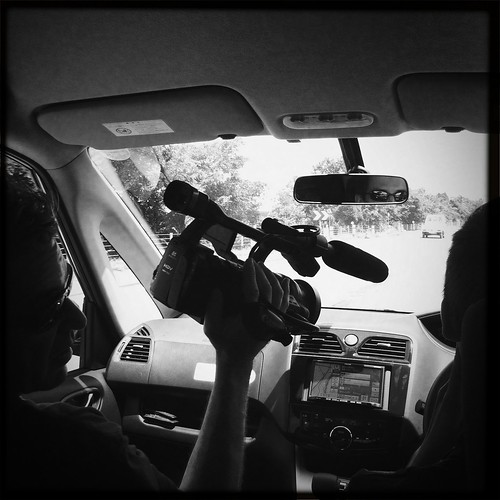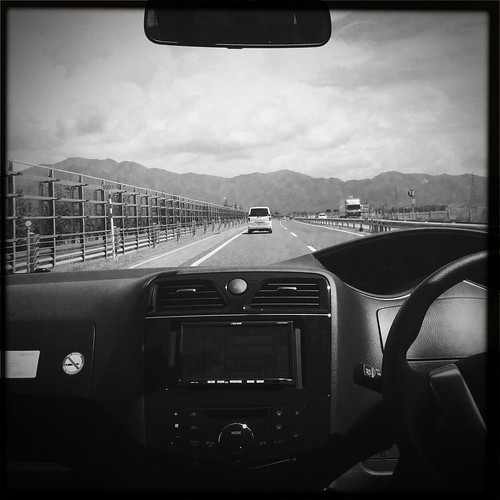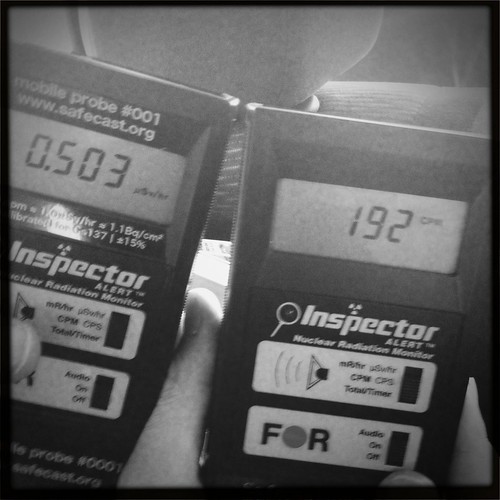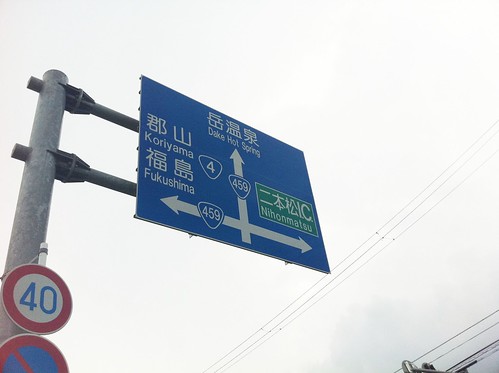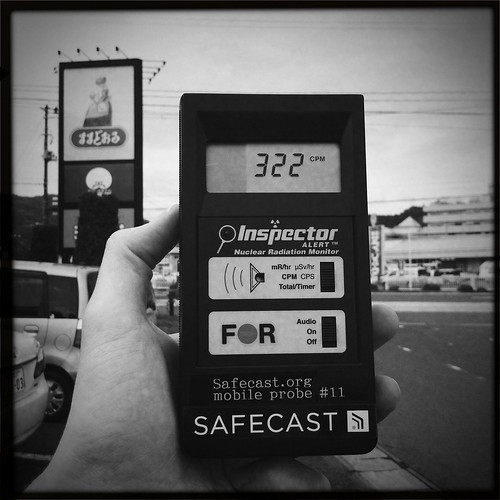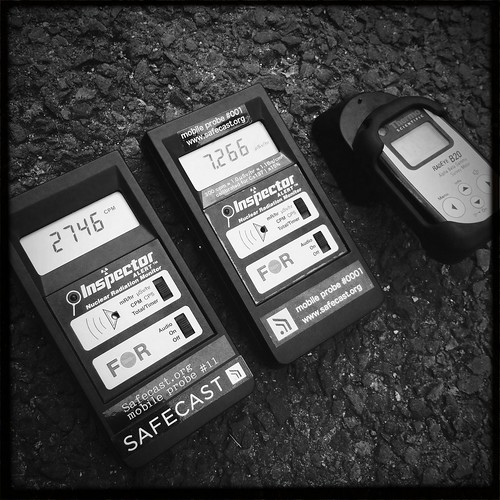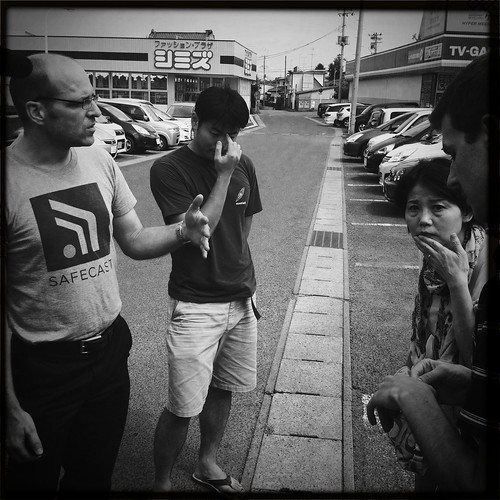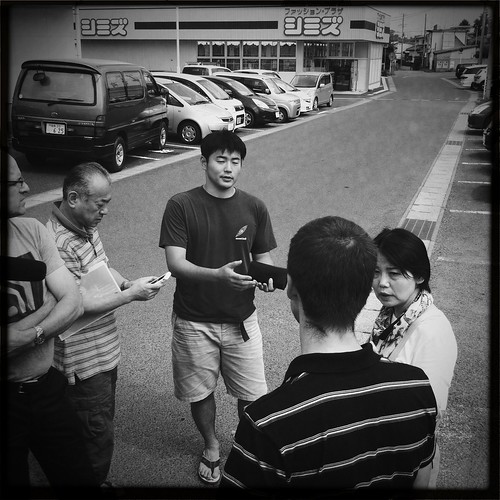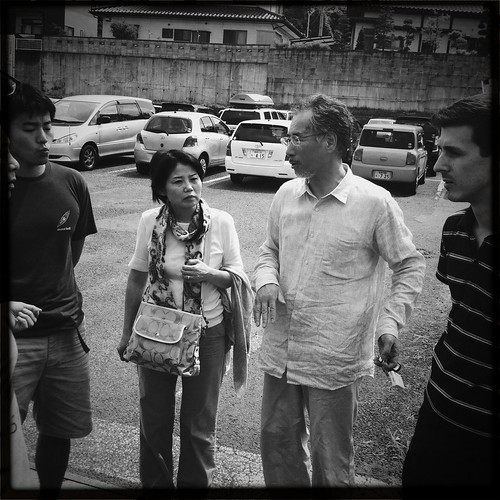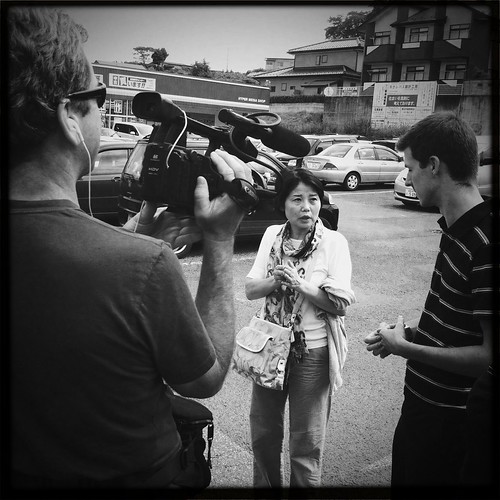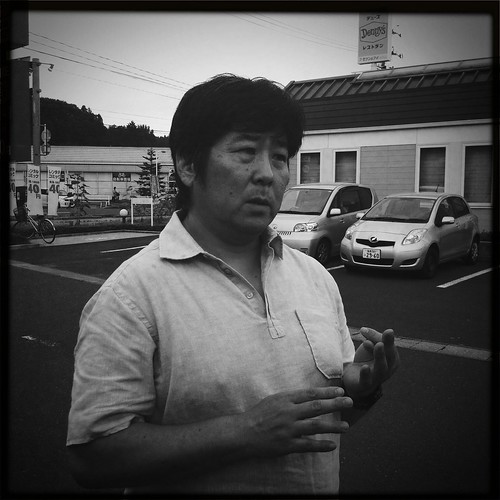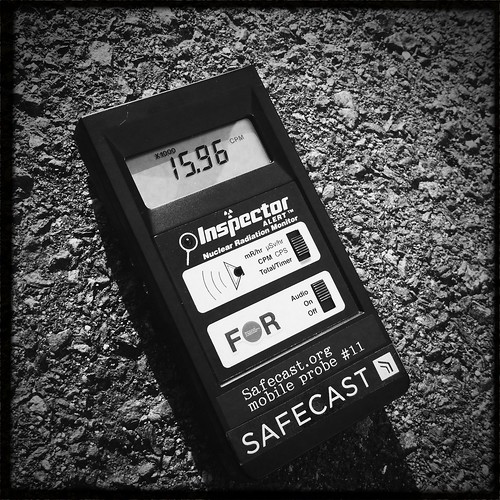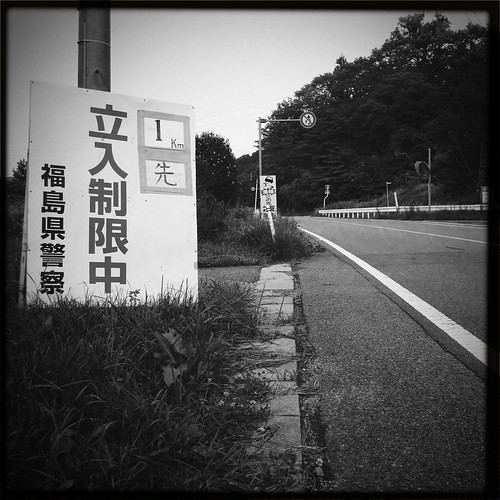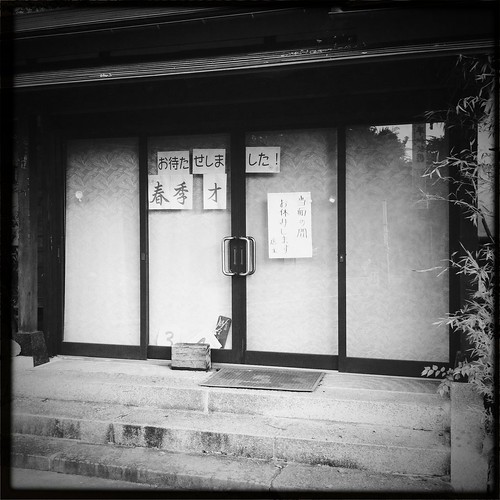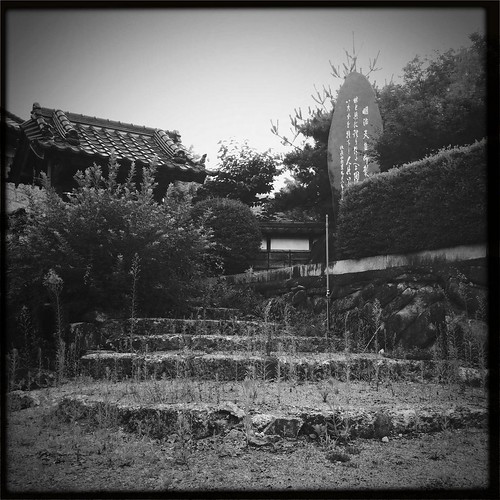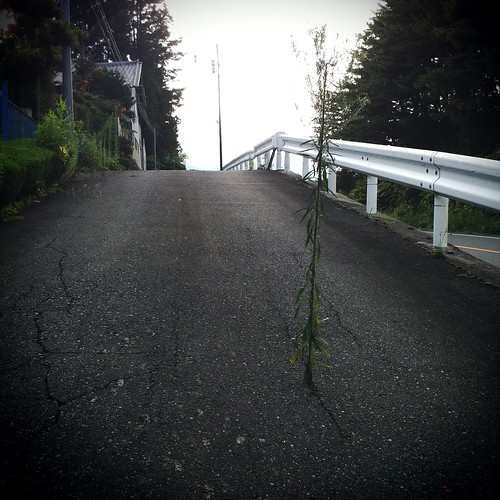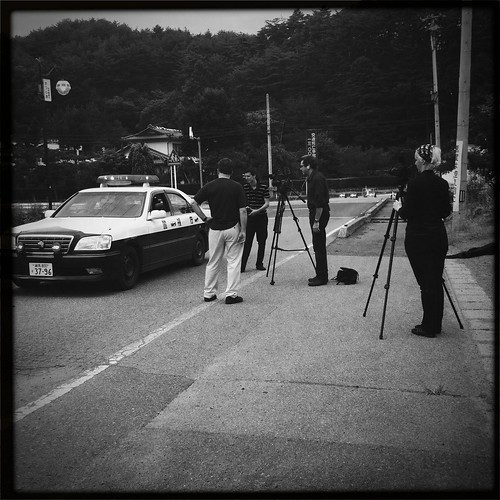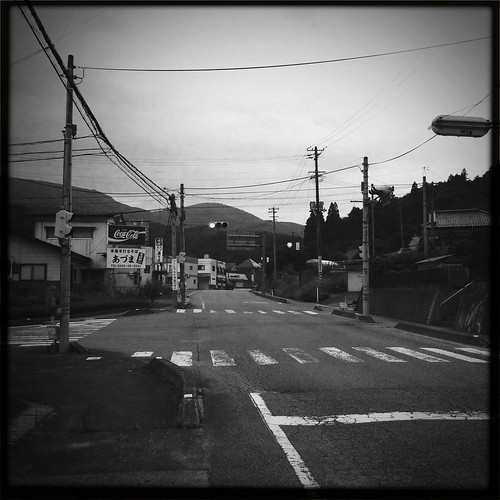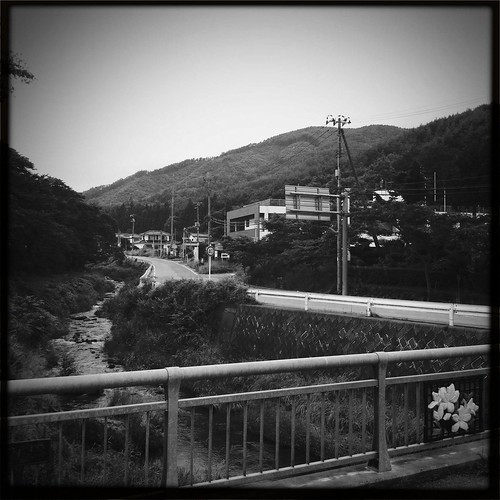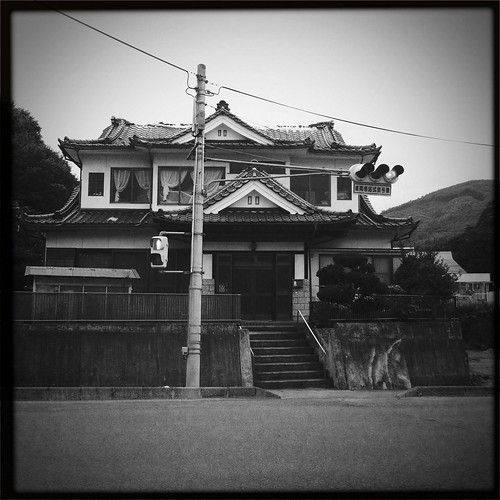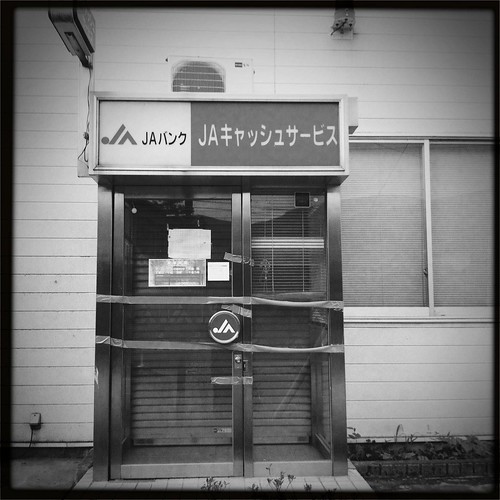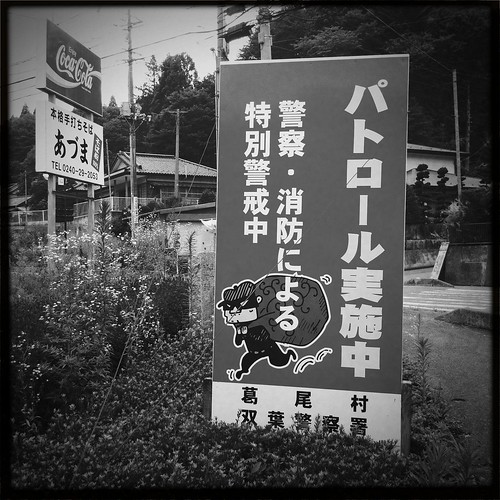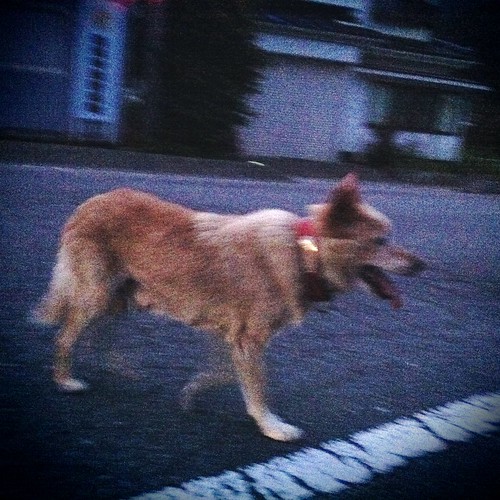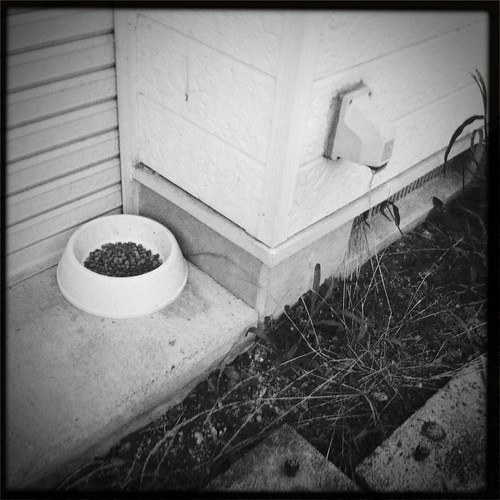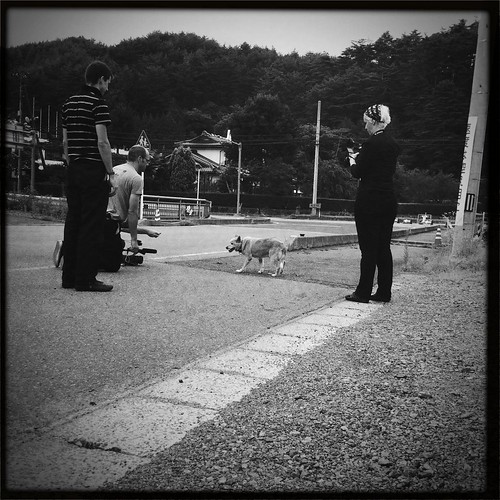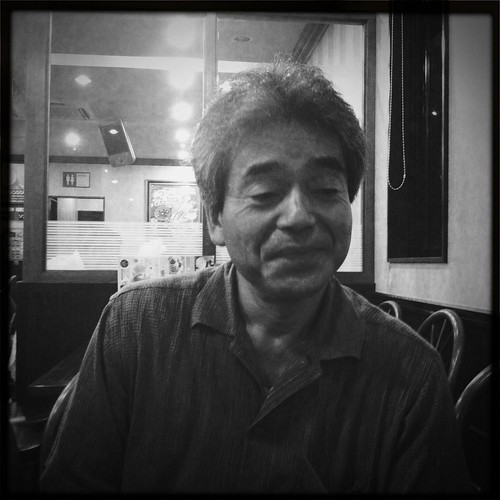The Safecasting drives officially started after my last trip to Japan, so I’ve been watching from afar as Pieter and an ever growing volunteer team of total heros have set out time and time again to try and map the radiation levels in the areas surrounding the Fukushima plant, as well as the rest of Japan. Knowing that I was going to be back in Tokyo for a number of Safecast meetings and the Radiation Seminar at the same time that Miles O’Brien and Xeni Jardin were going to be working on a story for PBS News Hour that had some focus on Safecast, organizing a drive seemed like an obvious option.
This morning Pieter, Xeni and I (pictured above) set out with Miles, along with father/son superteam Joe and Bryan Moross. The plan was to drop off a few Geiger counters with volunteers and try to cover some some new ground, perhaps near the exclusion zone. But it ended up being so much more.「セーフキャスティング」と私達が呼ぶ走行測定が正式に始まったのは、私が前回日本を訪れた後でした。このため、どんどん増え続けるボランティアの皆さんとピーター(彼らは真のヒーローです)が、何度も時間をかけて福島原発周辺や日本各地の放射線レベルを計り、地図にしていく作業を、私は遠くから見ていました。私自身 Safecast のミーティングと放射線セミナーのために東京に戻るということ、また、同時期に Miles O’Brien と Xeni Jardin が PBS News Hour の Safecasat に焦点を当てたストーリーに取り組むことも知っていたため、来日中に走行測定を行うことは当然だと思っていました。
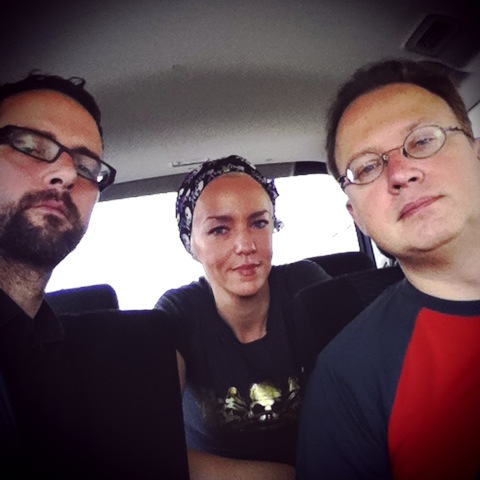
今朝、ピーター、Xeni と私(上写真)は、Miles、父と息子のスーパーチームである Joe Moross、Bryan Moross と一緒に出発しました。今回の旅の目的は、ボランティアの方達にガイガーカウンターを届けること、まだ放射線レベルを測定していない新しい場所、できれば警戒区域の近くをカバーすることでした。しかし結果的にこれより盛りだくさんの旅となりました。
(While Miles and Xeni were filming throughout, those bits were for PBS and will certainly be available sometime in the future, so this account is mostly my own observations, unless noted all photos are also by me.)
The day began in Shinjuku around close to 7:30am when we picked up a rental car, this was a large group with a lot of gear so we had a need for two vehicles and the usual Safecast car on it’s own wasn’t quite enough. We wasted no time and started driving north. Depending on where you are in the city, background radiation levels in Tokyo hover right around 50 CPM which is only slightly higher than what we believe they were prior to 3/11 though we weren’t measuring things then so can’t be positive. For our purposes we are assuming the average around the country was 35 CPM which is worth noting before I start mentioning numbers going forward. It wasn’t too long in our trip before we hit our first hotspot in Nasu.
Our first stop was Nihonmatsu which is not too far from Koriyama to meet up with some volunteers in the area and hand out a few new sensors for them to take measurements with. We met at restaurant and of course started measuring things the moment we set foot in the parking lot. Levels were noticeably higher than we’d seen just a few hours prior in Tokyo.
Another bit worth noting here in case you haven’t been following along with the work Safecast has been doing so far, surface contamination is much higher than air contamination. There are two main reasons for this – “Fallout” literally means this radioactive crap fell out of the sky and found it’s new home on the ground, and much of contents of said crap are beta emitters. Beta radiation is lower energy than gamma so you need to get close to it to measure it – which in this case is the ground. If you only measure the air you miss the betas all together. Anyway. Surface is higher than air, and around 3000 CPM on the ground in the parking lot here is 10X the air levels.
As occasionally happens when we are measuring out in public, people approach us to find out what we’re doing.
People are curious, and often they are concerned.
Hiroko Ouchi was both. On top of that she was upset.
She said that she hasn’t been able to get any information about the levels around them, the levels they are living in from the government or TEPCO. She said at first she wasn’t concerned because residents were told everything was fine and not to worry, but over time people started taking readings on their own and hearing about readings taken by others that suggested things weren’t all fine and this really stressed her out. This area is far enough away from the plant that no one is being officially evacuated, which means anyone who wants to leave has to do it on their own and pay for it themselves. This has caused a lot of trauma in the community as some people leave and some people stay. Ouchi-san said it is very upsetting for people to be in this position and have their questions go unanswered.
Ouchi-san went on to say that she’s most worried about the younger people and children who might not have the means to move away, as they are the ones who could suffer most in the long term from exposure to this radiation. She was excited to learn about the mapping that Safecast was doing and took our cards so she could see the site and maps when she got home. Before leaving she thanked us repeatedly and expressed sincere gratitude for our efforts, and again extreme disappointment that the government hasn’t done the same.
This was a totally unexpected event but helped put us in the mood for the rest of the day. Before heading out we have new Safecast volunteer Washiyama-san a brand new bGeigie so he can help map the area street by street. If all goes well we’ll get him several more devices in the coming weeks for his whole team to put to good use and then send the data back to us.
Once back in the car we decided to head east and see how close we could get to the exclusion zone. We watched the readings rise and fall, though generally increase on the whole the further we went. We have a device outside of the car, and several inside taking readings. At many points we would see a 25% increase depending on which side of the car we pointed a device towards. Very quick changes in very small areas here. At one point things seemed to be increasing very rapidly and at much higher jumps than we’d seen previously. We were so distracted by the drastic readings that we almost ran right into a roadblock staffed by several police officers who were standing around in the street.
We turned past them and drove down the road a short ways and then stopped to look at our devices which were completely blowing up.
On my last transatlantic flight I measured over 800 CPM on the flight. Seeing over 1000 CPM in the car was a bit shocking, opening the door and putting the device on the ground in the middle of the street and seeing it climb, in a matter of seconds, to almost 16,000 CPM was, well, I still don’t even know how to describe it. I was completely taken aback by this. We were maybe one city block from where the officers were standing – outside and unprotected and decided we needed to go back and talk to them.
The officers were very polite and happy to talk to us. We asked them if they were concerned that they were standing outside all day with no protective gear and they told us their bosses have assured them it is perfectly safe and so they have to trust them. We told them about the readings we’d taken just steps from where they were and offered to show them personally that the levels were incredibly high – they declined saying they needed to trust the authorities. Which was weird, because to most people – they are the authorities. We measure radiation all the time, and were noticeably shaken after seeing the readings we just had, and these guys were being told there was nothing to worry about. Suddenly some sort of commanding officer arrived and told us we had to leave and everyone stopped talking to us. Like turning off a switch.
We got back in the car and drove about 1km away the other direction away from the roadblock.
There was a small restaurant that was closed up and seemed like a good place to stop, take some measurements and talk about what had just happened. This was the first time I realized there wasn’t anyone else around really. All the buildings I could see were closed up, no cars, no lights, no one home. From the look of the weeds and growth, they had been gone for quite some time.
This restaurant had signs taped in the window saying basically “Sorry we are closed for an undetermined period of time. Will try to reopen in the spring.”
Unfortunately I think that’s being a bit optimistic.
It was here that we took our highest and most concerning readings of the day. The parking lot of the restaurant was active, but less than we’d just seen. But when we walked across the street – maybe 10 feet away, we measured over 20,000 CPM and 9 µSv/hr. We pulled out our SAM 940 to try and identify the isotopes and found things we weren’t expecting at all. So we grabbed some samples to send to a lab for professional analysis and got out of there quick.
We drove for a little ways until we found an area with fairly low levels where we felt safe stopping to film a few interviews for the PBS piece. This was a good 10-15 minutes away from the barricade we’d just encountered and the area was still a ghost town. No one anywhere. With the exception of the sound of a nearby stream, complete silence. Until a police officer rolled up.
He started off with the Japanese variation of “You folks aren’t from around here are you…” He was friendly and once convinced we weren’t looters left us on our own. Over the hour or so that we were in the area we saw a police car every 10 minutes or so, at least, but no other people. This was pretty striking, I’d prepared myrself for what I thought I was going to see, but sometimes it’s what you don’t see that gets to you.
While the people had clearly packed up and moved out, that didn’t seem to translate to the animals. First of all there were giant wasps dive bombing us all day. Luckily no one got stung, but seriously these things had to be close to 3″ in length. Much less scary but more heartbreaking was the pets that had for one reason or another been left behind. We several dogs, with collars and a cat who hung around us. All of them looked fairly skinny despite that there seemed to be several bowls of food left around for there. All the animals seemed a bit nervous and cautious, some came closer than others, all left pretty quickly. Almost as if they were looking for something, or someone. There was also a sign with photos of dogs that had been found and rescued – hoping their owners would claim them. That sign was from May 1st, and hadn’t been updated so no idea what happened next.
As we were starting to wrap up a car drove by and came to a quick stop. Two gentlemen got out, one of them was a reporter for Asahi TV and the other was Tadao Mumakata, a resident of Koroyama who is working on a way to produce geiger counters locally. They knew about Safecast and were excited to run into us. We talked for a while and then decided to go get some food before heading back to Tokyo.
We stopped at a smallish family restaurant and talked about our plans and goals, geiger counts and what we’d learned – hoping to pass some of this on and hopefully help someone skip over some of the early mistakes we’d made ourselves. They were happy for the info and we exchanged contacts for further discussion.
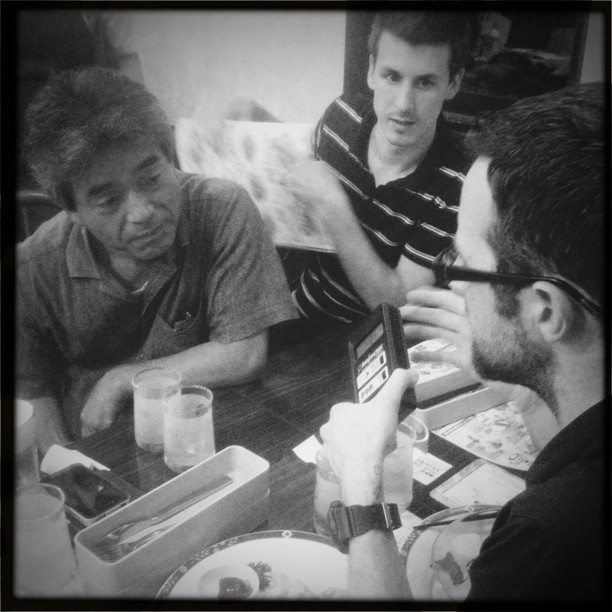
(Above photo, with me in it talking to Mumakata-san taken by Xeni)
We bowed, shook hands, and went our separate ways. Back to Koriyama for them, and back to Tokyo for us. Our drive was going to take a few hours longer. Finally around 2:30 am we made it back and started dropping people off at their respective houses/hotels. But no spare moment could be wasted. At the final stop we uploaded the log files from the bGeigie – the geiger counter we had mounted outside of the car all day logging radiation and mapping it against GPS points. This produces a map of the whole drive, and dumps the data into our full database, filling in a few more pieces of the big picture.
And it really is a big picture. These places have never had the kinds of detailed measurements we’re taking, and the measurements that have happened haven’t been shared openly with the residents – who without question are the ones who need to have that info the most. I’ve known this since we started the project but seeing it first hand today and hearing people thank us for trying and for caring was heavy. This project is important and I’m so honored to be a part of it, and so glad to have others involved who have done the impossible to get us this far already.

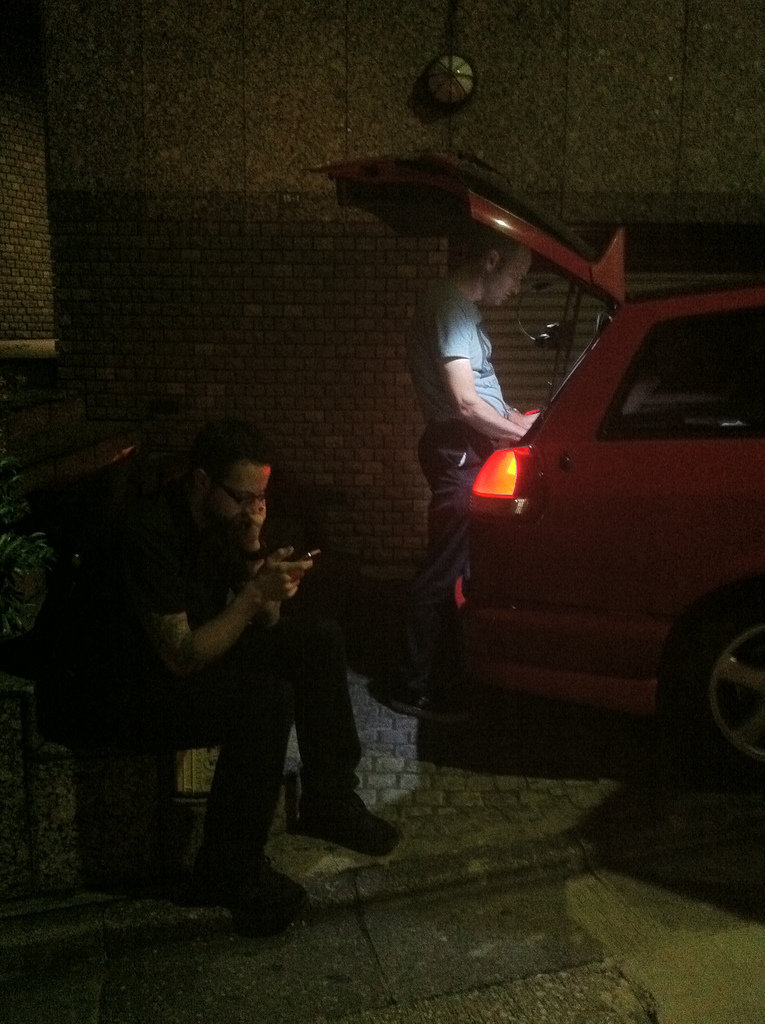
(photo by Pieter Franken)
I was back in my hotel room by 3am, and I’ve spent the last 3 hours putting this report together while it was all still fresh in my mind. I have a flight to Los Angeles in a few hours, so now it’s time to sleep. As much as it’s annoying to end this on a begging note, driving two cars (granted we usually only need one) around Fukushima all day, including gas and tolls clocks in at just shy of $500. We’ve got a paypal donate button on the top right hand side of this page. If you wanted to throw $5 or $10 our way it would help us chip away at that and help fuel the next one.
( Miles と Xeni は PBS 用にずっと撮影をしていました。もちろんこの映像は、後日視聴が可能になると思いますので、この報告は基本的に私の個人的な意見です。写真も特に記載のないものは、すべて私が撮影したものです。)
この日は、朝 7 時半頃に新宿でレンタカーを借りるところから始まりました。今回は人数も多く、機器もたくさん持っていたので、普段使用している Safecast の車だけでは狭すぎるため、レンタカーを 1 台借りて合計 2 台での旅となりました。私達は早速北に向かって走り出しました。東京のどこにいるかによって、バックグラウンド(背景)の放射線レベル(ここでは空中の放射線レベルの意)は 50 CPM 前後で推移します。これは、3 月 11 日以前の数値よりも、やや高いくらいの数値と思われますが、3 月 11 日以前のデータがないため、断言はできません。これから数値に言及していくにあたり説明しておくと、私達は日本全国の平均値を 35 CPM と想定しています。走行後まもなく、私達は那須に存在する最初のホットスポットに行き当たりました。
私達の最初の目的地は二本松市でした。二本松市は郡山市からすぐのところで、ここでボランティアの方々に会って、新しいセンサーを渡すことになっていました。レストランで待ち合わせをし、駐車場に乗り入れてすぐに計測を始めました。数値は数時間前に東京で見たものよりも、顕著に高くなっていました。
これまでに Safecast が行ってきた活動内容を把握していない方のために説明しておくと、地表汚染の数値は空中汚染の数値よりもかなり高くなります。これには、大きく分けて二つの理由があります。「放射性降下物」はその言葉通り、放射性物質が空から降りてきて地表にとどまったものです。この放射性物質の大部分はベータ放射体です。ベータ線はガンマ線よりもエネルギーが弱いため、検出するには近くに寄って計測する必要があります。この場合は、地面に近寄って計測するということになります。空中だけで数値を計った場合は、ベータ線を計り損ねることになります。とにかく地表の数値は空中の数値よりも高くなります。この駐車場で計った地面の数値は約 3,000 CPM で、これは空中の放射線レベルの約 10 倍の値でした。
公の場で数値を計っているとときどきあるのですが、今回も私達が何をしているのかと人々が集まってきました。
好奇心から集まってきた人は、多くの場合心配もしておられます。
おおうち・ひろこさんはその両方で、動揺しておられました。
おおうちさんは、自分の身の回りの放射線レベルに関する情報を政府や東京電力からは全く得ることができないと話しました。最初は、問題無いし心配することはないと住民達は言われていたので、彼女も心配していませんでした。しかし、そのうち自分で数値を計る人が出てきたり、他の人が計った数値を耳にするようになり、その数値は決して大丈夫なものでは無かったため、彼女もストレスを覚えるようになりました。この地域は、原発からも遠く正式な避難地域にはなっていないため、避難したい人はすべて自費で避難しなくてはなりません。避難する人もいれば、避難しない人もいます。このことが、住民達に大きな心的外傷を与えています。おおうちさんは、質問にも答えてもらえない、こういった状況に残されている人々は非常に混乱していると話していました。
おおうちさんは、引っ越す意志の無い若い人と子供達が一番心配だと言っていました。若い人と子供達が、長期的にみて、この放射線に曝されることで一番被害を被ると思われるからです。彼女は Safecast の取り組んでいる放射線マッピングにも非常に興味を示し、自宅に戻ってからサイトと地図を確認できるようにと、私達の名刺を持ってかえりました。別れ際には、私達の行動に何度も感謝してくれました。また、政府が同様の対応をしてくれないことに対して非常に不満を示していました。
これは全く予想外の出来事でしたが、この日、私たちの気持ちを後押ししてくれるものとなりました。次の目的地に向かって出発する前に、Safecast の新しいボランティアであるわしやまさんに、真新しい bGeigie をお渡ししました。彼の協力によって、このエリアの道路ごとの地図を作成できるようになります。全てうまくいけば、今後数週間のうちに、彼のチーム用に追加の機器をいくつか用意してお渡しし、わしやまさんチームが採取したデータを Safecast に送り返してもらえるようになる予定です。
車に戻って、今度は東に向かい、警戒区域にどこまで近づくことができるか試してみることにしました。数値は上がったり下がったりしましたが、進めば進むほど、全体的には上がっていきました。車外には一台、車内には数台の機器を設置していました。多くの場所で、機器を向ける方向によって、25 %の上昇を目にしました。ここでは、ほんの少しの場所の違いで、大きな数値の差が現れます。ある場所では、これまでは見なかったほど急激に数値が上昇しました。この急激な数値の変化に気を取られて、あやうく道の真ん中に立っていた警察官達による道路封鎖物に突っ込むところでした。
車をターンして、彼らのいる場所を通り過ぎ、少し走ったところで停車して測定器を見たところ、数値は劇的に上がっていました。
前回大西洋を横断する便で、飛行中に計測した数値は 800 CPM 強でした。車の中で 1,000 CPM 以上の数値を見るのは、少しショッキングでした。車のドアを開け、機器を道路の真ん中に置いて測定をしたところ、あっと言う間に数値は 16,000 CPM を超えました。今でもこの時の気持ちをどう表現したらいいか分かりません。私はぼうぜんとしました。そのとき私達は、何の防護も施さずに屋外に立っている警官達がいた場所から、おそらく 1 街区ほど離れたところにいたと思います。私達は引き返して彼らと話さなければと考えました。
警官はとても礼儀正しく、喜んで私達と話してくれました。防護服も着ずに一日中外に立っていることは心配ではないかと尋ねると、上司が全く安全だと断言したため、上司を信じなければならないとのことでした。私達は彼らの立ち位置のすぐ近くで計測した放射線測定値について伝え、その非常に高い測定値を実際に見てもらおうとしましたが、彼らは当局を信じなければならないからと、私達の申し入れを断りました。多くの人は警官自身を当局と思っているわけですから、彼らのこの発言には妙な感じがしました。私達は常に放射線を測定し、つい先ほど計測した数値の高さを見て明らかに動揺しているのに対し、彼らは上司に心配することは何もないと言われているわけです。突然、指揮官らしき警官が現れ、私達にすぐに立ち去るよう指示しました。それまで話していた警官も、まるでスイッチを切られたように話すのを止めました。
私達は車に戻り、立ち入り禁止の地点から 1 キロほど離れたところまで走りました。
閉店した小さな食堂があったため、周辺の測定と今起きたことについて話をするため車を止めることにしました。このとき私は初めて、周囲にほとんど誰もいないことに気づきました。すべての建物は閉まっており、車もなく、点いている電灯もなく、家には誰もいない。雑草の伸び具合を見ると、皆が去ってからかなりの時間が経っているようでした。
立ち寄った食堂の窓には、「当面の間お休みします」とありました。
この日最も高く、最も懸念される数値を計測したのはこの場所でした。食堂の駐車場でも高い数値を示しましたが、先ほど測定した数値までは上がりませんでした。しかし道を渡り、おそらく 3 メートルほど離れた場所で、20,000 CPM 以上、9 µSv/h 以上を測定しました。 SAM 940 を取り出し同位体を調べたところ、全く予期していなかった結果が示されました。このため私達は研究所で専門家に解析してもらうためサンプルを手早く採取し、急いでその場を離れました。
その後少し車を走らせ、比較的測定値が低く安心して車を止め PBS のための撮影ができそうな場所を見つけました。先ほど私達が遭遇した警官が立っていた立ち入り禁止区域から 10 ~ 15 分ほど離れた場所でしたが、そこはゴーストタウンのようでした。人ひとり見当たりません。近くを流れる小川の音が聞こえるばかりで、しんとしていました。そこにパトカーに乗った警官が現れました。
警官は「あなたたちはこの辺の人じゃありませんね」といったことを話しかけてきました。彼はフレンドリーで、私達が略奪者ではないことが分かると去っていきました。一時間ほど走ると、少なくとも 10 分置きにパトカーを見かけるようになりましたが、警官以外は誰一人見当たりませんでした。このことに私はかなり驚いていました。私は自分が見ることになるだろうと予想していたものを見る心の準備はしていたのですが、あるべきものがないことに衝撃を受けることも時としてあるのです。
人々は明らかに引っ越してしまったようでしたが、これは動物達には当てはまらないようです。まず、非常に大きなスズメバチが一日中私達に向かって飛んできました。幸い誰も刺されませんでしたが、実にスズメバチの大きさは長さが 7 センチほどもありました。スズメバチのように怖くはありませんが、見るのがとてもつらかったのは、様々な理由で置いていかれたペット達の姿でした。首輪をした犬が何匹かと、一匹の猫が私達のまわりをうろうろしていました。ペットフードの入った容器がいくつか置かれていましたが、ペット達はかなり痩せて見えました。どの動物達も少し不安そうで用心深く、それなりに近寄ってきては、どの子もすぐに離れていきます。まるで何かを、または誰かを探しているようです。飼い主が現れることを期待して、保護された犬の写真が掲載された張り紙もありました。張り紙の日付は 5 月 1 日となっていて、それ以来更新されていなかったので、その後どうなったのか分かりません。
私達が帰る準備をしていると、一台の車が通りかかり、急に止まりました。男性が 2 人降り立ちました。一人はテレビ朝日のレポーター、もう一人は郡山在住で、地元でのガイガーカウンター製造に向けて取り組んでおられる宗像忠夫さんでした。二人とも Safecast についてご存じで、私達と遭遇したことに感激して下さいました。しばらくの間話をし、東京に戻る前に食事をしようということになりました。
私達は小さめのファミレスで止まり、私達の計画と目標、ガイガーカウンターの測定値や学んだことを話しました。私達の経験を伝え、初期に経験した間違いを他の人がしないで済むようにと望んでのことです。二人は情報の共有を喜んでくれ、さらに議論できるよう連絡先を交換しました。

(写真は、私と話す宗像さん。撮影: Xeni )
私達はお辞儀と握手をして、それぞれの帰路につきました。彼らは郡山へ、私達は東京へ。彼らより数時間長い道のりを経て、ようやく東京についたのは夜中の 2 時半で、皆をそれぞれの家やホテルで降ろしました。しかし時間を無駄にはできません。最後の行先で、車の外側に取り付けられていた bGeigie (一日中放射線測定値をログに記録し、データを GPS 上でマッピングしたガイガーカウンター装置)から、ログファイルをアップロードしました。これにより今回の走行のマップがアップされ、私達の総データーベースにデータを追加して、全体像を把握するための情報をまた少し追加することができました。
全体像を把握するのは大仕事です。私達が行っているような詳細測定はこれらの地域では行われておらず、測定された数値は、間違いなく情報を最も必要としている住民の方に対して、オープンになっていません。私達がプロジェクトを開始した時からこのことは理解していましたが、今日実際に見て、私達の試みや関心に対し感謝する人々の声を実際に聞いたことは、重い経験でした。このプロジェクトは重要であり、そこに参加していることを誇りに思いますし、不可能を可能にしプロジェクトを短期間でここまで押し進めて下さった人達がいることを本当にありがたく思います。


(撮影:Pieter Franken )
ホテルの部屋に戻ったのは夜中の 3 時で、まだ記憶が新しいうちにと、その後 3 時間をかけてこの報告記事を書いています。数時間でロサンゼルス行きの便に乗るため、もう寝なければいけません。この記事を支援のお願いで終わらせるのは我ながら気に障るのですが、車 2 台(普段は 1 台で済みますが)で福島を一日中走り回った費用は、ガソリンと高速料金を含め 500 ドル弱でした。このページの右上のあたりに Paypal の寄付(「 Donate 」)ボタンがあります。5 ドルでも 10 ドルでも寄付して下されば、集まった寄付金を少しずつ使い次からの走行に使わせていただくことができます。
(訳:Hiroyo, Emmy, Meg)
